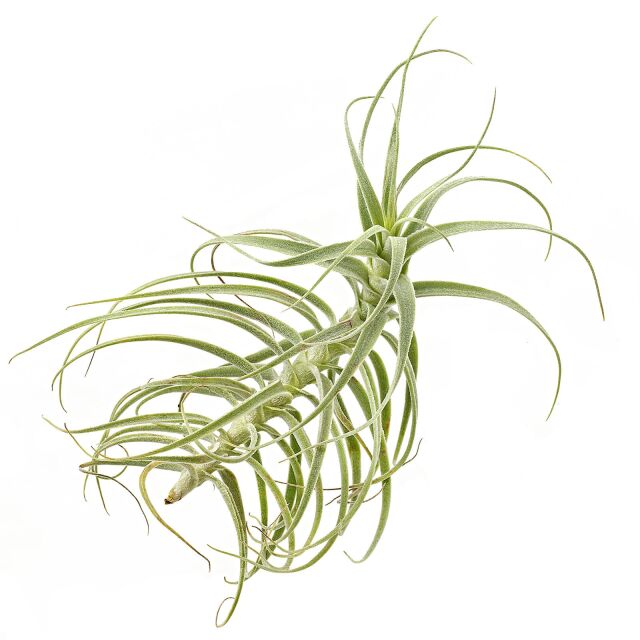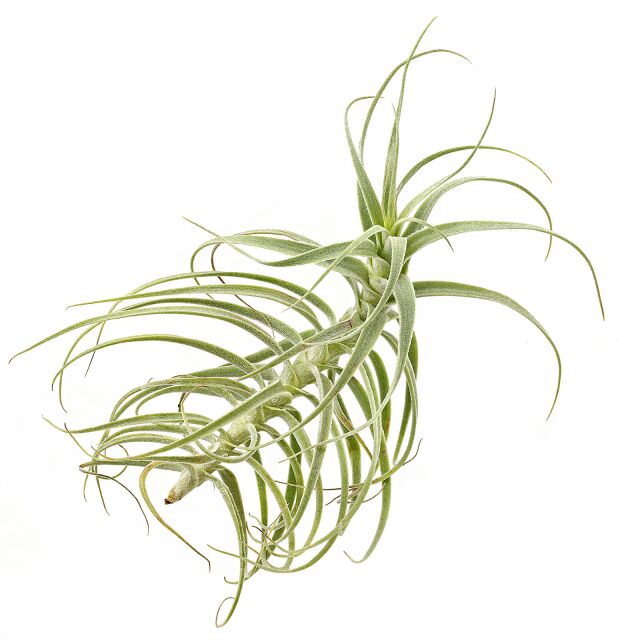Purple air plant



Tillandsia purpurea
Purple air plant
- Desert Tillandsia from Peru
- Up to 20 cm long leaves
- Forms densely leafy stems
Sign in or Register
Item question
We’re here for you!
Please enter your question and e-mail and we’ll contact you as soon as possible. It usually takes us up to 24 hours during business days to respond.
Thank you for your question!
Thank you, we’ll get in touch!
Close window
You already sent us a question.
Please wait a few minutes
Description
Most Tillandsias grow in nature as epiphytes on trees and shrubs, but Tillandsia purpurea grows on sand and rocks in the coastal desert of Peru. It hardly ever rains there, but the plant absorbs water from the mists that rise from the Pacific. This species has leaves up to 20 cm long on one stem and forms dense tufts through pups.
Tillandsia purpurea is counted among the "Grey Tillandsia" type. These usually come from drier places, in this case with little rain but a lot of fog. These "air plants" absorb water and nutrients completely via the many absorbent scales on the leaves, even from very humid air. The roots, if still present, serve as adhesive roots. In culture, such Tillandsias are tied or glued to solid materials such as wood or stones. The light requirement is high. The air must not be very humid and stagnant all the time, because the plants need to be able to dry out. Therefore, "Grey Tillandsias" are not well suited for rainforest terrariums, or they need a drier, well-ventilated place in them. One sprays Tillandsia purpurea with soft water about once to three times a week. Dipping is also possible. An orchid and Tillandsia fertiliser can be added with every second watering. Propagation is done by cutting off offspring.
This true desert Tillandsia can be attached to a bright spot on rock or wood and is particularly suited to designs inspired by semi-deserts.
Profile
| Tillandsia purpurea | |
| Cultivation options | Epiphytic, freely hanging |
| Growth height | Approx. 10 - 15 cm |
| Temperature | 15 - 25 °C, not below 10 °C |
| Humidity | 50 - 70 % |
| Light requirement | Bright, indirect light; partially tolerates direct sunlight |
| Watering | Soft, low-lime water, spray 2-3 times a week, depending on humidity and temperature |
| Fertilisation | Every 2 months with diluted liquid fertiliser for bromeliads during the growth phase |
| Propagation | Offset formation on the mother plant, seeds |
| Suitable for | Small to medium-sized terrariums, air terrariums, epiphytic gardens |
| Cultivation options |
| Epiphytic, freely hanging |
| Growth height |
| Approx. 10 - 15 cm |
| Temperature |
| 15 - 25 °C, not below 10 °C |
| Humidity |
| 50 - 70 % |
| Light requirement |
| Bright, indirect light; partially tolerates direct sunlight |
| Watering |
| Soft, low-lime water, spray 2-3 times a week, depending on humidity and temperature |
| Fertilisation |
| Every 2 months with diluted liquid fertiliser for bromeliads during the growth phase |
| Propagation |
| Offset formation on the mother plant, seeds |
| Suitable for |
| Small to medium-sized terrariums, air terrariums, epiphytic gardens |
Terrarienpflanzen
Our terrarium plants give every terrarium an individual, natural atmosphere and at the same time provide a healthy environment for all terrarium inhabitants. Our wide range of tropical, subtropical and even arid plants are easy to combine and enhance any terrascape. Whether it's strong succulents, subtle tillandsias, eye-catching neoregelias or wonderful orchids - we offer terrarium plants for different terrascapes from rainforest to desert.
General information
Please choose a variant to see more information.
| Item no. |
|
| EAN | |
| Weight | |
| Shipping weight |
Customers ask customers
You have questions about this product? Ask other customer or our support team about this product!